Class 12 Chemistry Chapter 2 Electrochemistry Notes FREE PDF Download
Electrochemistry is a vital section of chemistry that determines the function of electrodes and reactors. Vedantu’s Electrochemistry notes class 12 tries to situate the ideas behind the chemical reactions.
 Table of Content
Table of ContentClass 12 Electrochemistry Notes explain this function of electrons where two metallic electrodes are present. These metallic electrodes are immersed in an electrolytic solution for power generation. By thorough reading of Electrochemistry Class 12 Notes PDF Download, students will know that the ionic conductor is a vital part of cells.
Class 12 Chapter 2 Electrochemistry lets you quickly access and review the chapter content. For a comprehensive study experience, check out the Class 12 Chemistry Revision Notes FREE PDF here and refer to the CBSE Class 12 Chemistry syllabus for detailed coverage. Vedantu's notes offer a focused, student-friendly approach, setting them apart from other resources and providing you with the best tools for success.
Access Class 12 Chapter 2 Electrochemistry Notes
Electrochemistry
Electrochemistry is the study of generating electricity from the energy produced during a spontaneous chemical reaction, as well as the application of electrical energy to non-spontaneous chemical changes.
Electrochemical Cells
A spontaneous chemical reaction is one that can occur on its own, and in such a reaction, the system's Gibbs energy falls. This energy is then transformed into electrical energy. It is also feasible to force non-spontaneous processes to occur by providing external energy in the form of electrical energy. Electrochemical Cells are used to carry out these interconversions.
Types
Two types of electrochemical cells are present: Galvanic cells, which converts chemical energy into electrical energy and electrolytic cells which converts electrical energy into chemical energy.
Galvanic Cells
A spontaneous chemical process or reaction is used to extract cell energy, which is then transformed to electric current.
For example, a Daniell Cell is a Galvanic Cell in which the redox reaction is carried out using Zinc and Copper.
Oxidation Half:
Reduction Half:
The reducing agent is
Electrodes are another name for half cells. The anode is the oxidation half, and Cathode is the reduction half. The cathode is a term used to describe a type of electrode. In the external circuit, electrons pass from the anode to the cathode. Negative polarity is assigned to the anode. Positive polarity is assigned to the cathode. Daniell Cell is a fictional character created by Daniell Cell. The anode is
Electrolytic Cell
These electrodes are submerged in an electrolytic solution that contains both cations and anions. When current is supplied, the ions migrate towards electrodes of opposite polarity, where they undergo simultaneous reduction and oxidation.
Preferential Discharge of Ions
When more than one cation or anion is present, the discharge process becomes competitive. Any ion that needs to be discharged requires energy, and if there are multiple ions present, the ion that requires the most energy will be discharged first.
Electrode Potential
It can be defined as an element's tendency to lose or gain electrons when in contact with its own ions, causing it to become positively or negatively charged. Depending on whether oxidation or reduction has occurred, the electrode potential will be referred to as oxidation or reduction potential.
Characteristics
The magnitude and sign of the oxidation and reduction potentials are equal.
Because E is not a thermodynamic property, its values do not add up.
Standard Electrode Potential
It can be described as an electrode's electrode potential measured in comparison to a standard hydrogen electrode under standard conditions. The following are the standard conditions:
A 1M concentration of each ion in the solution.
A 298 K temperature.
Each gas has a pressure of one bar.
Electrochemical Series
The half-cell potential values are standard and are represented as standard reduction potential values in the table at the conclusion, commonly known as the Electrochemical Series.
Cell Potential or EMF of a Cell
Cell potential is the difference between the electrode potentials of two half-cells. If no current is pulled from the cell, it is known as electromotive force (EMF).
For this equation, we take the oxidation potential of the anode and the reduction potential of the cathode.
Since the anode is put on the left and the cathode on the right, it follows therefore:
For a Daniel Cell, therefore:
Cell Diagram or Representation of a Cell
In accordance with IUPAC recommendations, the following conventions or notations are used to write the cell diagram. The Daniel cell has the following representation:
The anode half cell is written on the left, while the cathode half cell is written on the right.
The metal is separated from an aqueous solution of its own ions by a single vertical line.
Anodic Chamber:
Cathodic Chamber:
A salt bridge is represented by a double vertical line.
After the formula of the corresponding ion, the molar concentration (C) is placed in brackets.
The cell's e.m.f. value is written on the cell's extreme right side. As an example:
If an inert electrode, such as platinum, is used in the cell's construction, it may be written in brackets alongside the working electrode, as when a zinc anode is coupled to a hydrogen electrode.
Salt Bridge
The salt bridge maintains charge balance and completes the circuit by allowing ions to flow freely through it. It contains a gel containing an inert electrolyte such as
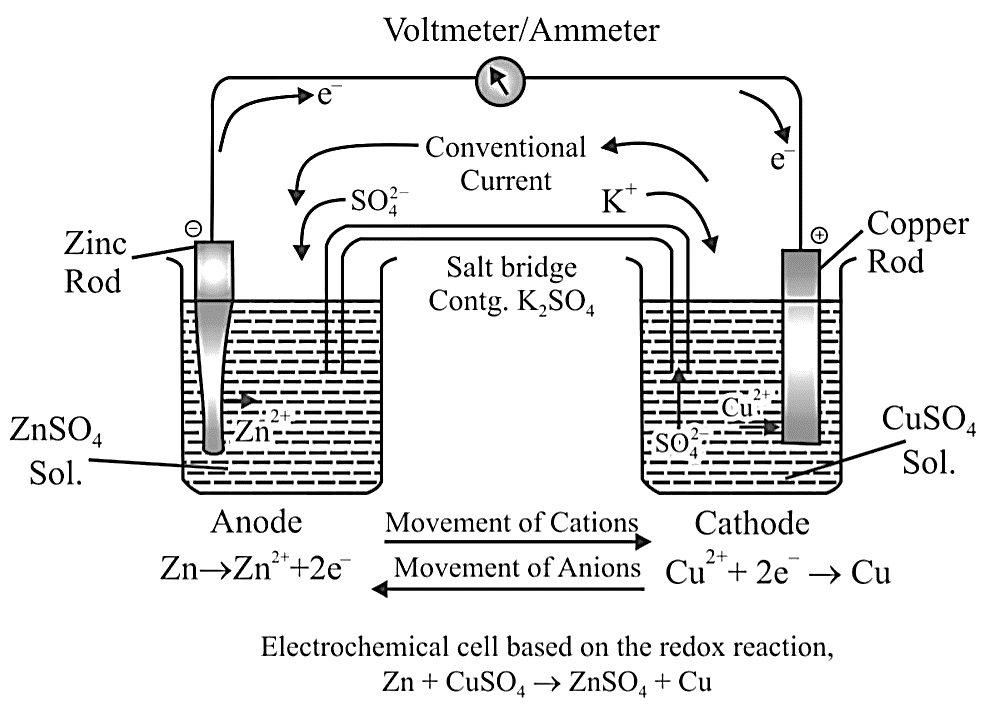
Spontaneity of a Reaction
In the following equation, if we take the standard value of cell potential, we will also get the standard value of
Types of Electrodes
Metal – Metal Ion Electrodes
An electrolyte solution containing metal ions is dipped into a metal rod/plate. Because of the potential difference between these two phases, this electrode can function as both a cathode and an anode.
Anode:
Cathode:
Gas Electrodes
Electrode gases such as
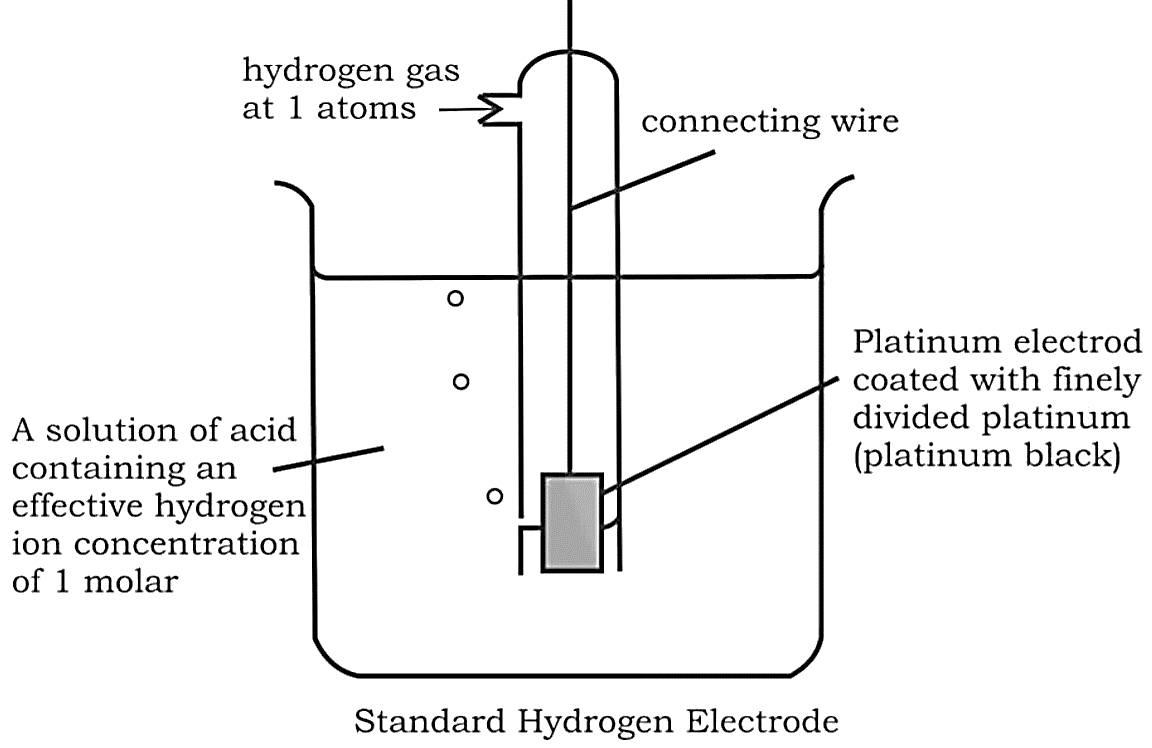
Anode:
Cathode:
The hydrogen electrode is also used as a standard for measuring the potentials of other electrodes. As a reference, its own potential is set at
Metal – Insoluble Salt Electrode
As electrodes, we use salts of several metals that are only sparingly soluble with the metal itself. When we employ
This electrode is made by dipping a silver rod in a solution containing
Calomel Electrode
Mercury is combined with two other phases: calomel paste
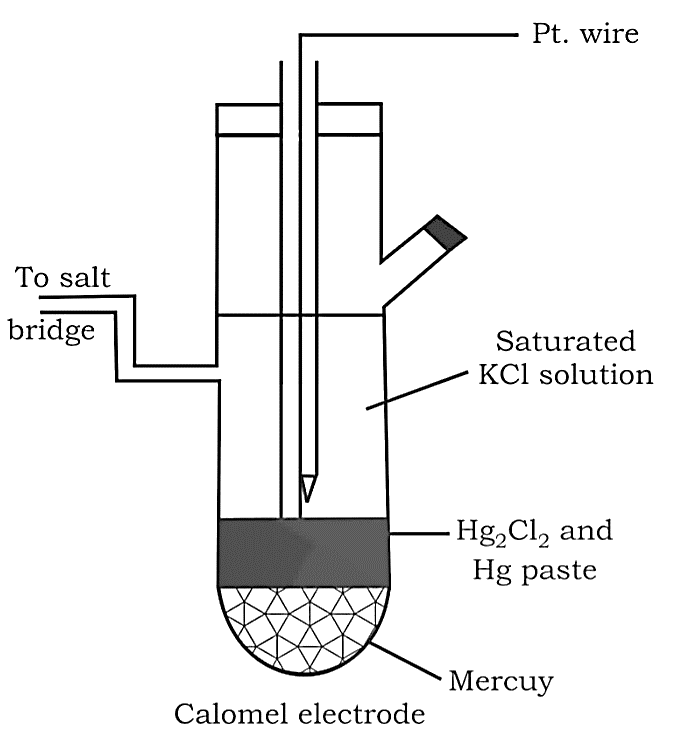
Cathode:
Anode:
This electrode is also utilised as a reference point for determining other potentials. It's also known as Standard Calomel Electrode in its standard form (SCE).
Redox Electrode
Two distinct oxidation states of the same metal are used in the same half cell in these electrodes. For example,
The following reactions may occur:
Anode:
Cathode:
Nernst Equation
It establishes a link between electrode voltage and ion concentration. When a result, as the concentration of ions rises, so does the reduction potential. For a type of generic electrochemical reaction.
Nernst equation can be given as:
Substituting the values of R and F we get:
Applications of Nernst Equation
Equilibrium Constant from Nernst Equation
For a Daniel Cell, at equilibrium
But at equilibrium:
In general:
Concentration Cells
Concentration cells are formed when two electrodes of the same metal are dipped individually into two solutions of the same electrolyte with varying concentrations and the solutions are connected by a salt bridge. As an example:
These Are of Two Types:
Electrode Concentration Cells
Where,
Electrolyte Concentration Cell
The EMF of concentration cell at 298 K is given by:
Where,
Cases of Electrolysis
Electrolysis of Molten Sodium Chloride
The reactions occurring at the two electrodes may be shown as follows:
At cathode:
At anode:
Overall reaction:
Electrolysis of an aqueous solution of Sodium Chloride
At cathode:
Thus
At Anode:
Thus,
Batteries
The term "battery" refers to a configuration in which Galvanic cells are connected in series to achieve a higher voltage.
Primary Batteries
Primary cells can be employed indefinitely as long as active components are present. When they're gone, the cell stops working and can't be used again. For instance, a Dry Cell or a Leclanche Cell, as well as a Mercury Cell.
Dry Cell
Anode: Zinc container
Cathode: Carbon (graphite) rod surrounded by powdered
Electrolyte:
Reaction:
Anode:
Cathode:
The standard potential of this cell is 1.5 V, which decreases as the battery is repeatedly discharged, and it cannot be refilled once used.
Mercury Cells
These are used in small equipments like watches, hearing aids.
Anode:
Cathode: Paste of
Electrolyte: Paste of
Anode:
Cathode:
Overall Reaction:
The cell potential is approximately 1.35 V and remains constant during its life.
Secondary Batteries
Secondary batteries are rechargeable for many applications and can be recharged multiple times. Lead storage batteries and
Lead Storage Battery
Anode: Lead
Cathode: Grid of lead packed with lead oxide
Electrolyte: 38% solution of
Discharging Reaction
Anode:
Cathode:
Overall Reaction:
To recharge the cell, it is connected to a higher-potential cell, which acts as an electrolytic cell and reverses the processes. At the relevant electrodes,
Recharging Reaction:
Fuel Cells
A fuel cell varies from a traditional battery in that the reactants are supplied externally from a reservoir rather than being stored inside the cell. In space vehicles, fuel cells are employed, and the two gases are supplied from external storage. The electrodes in this cell are carbon rods, and the electrolyte is
Cathode:
Anode:
Overall Reaction:
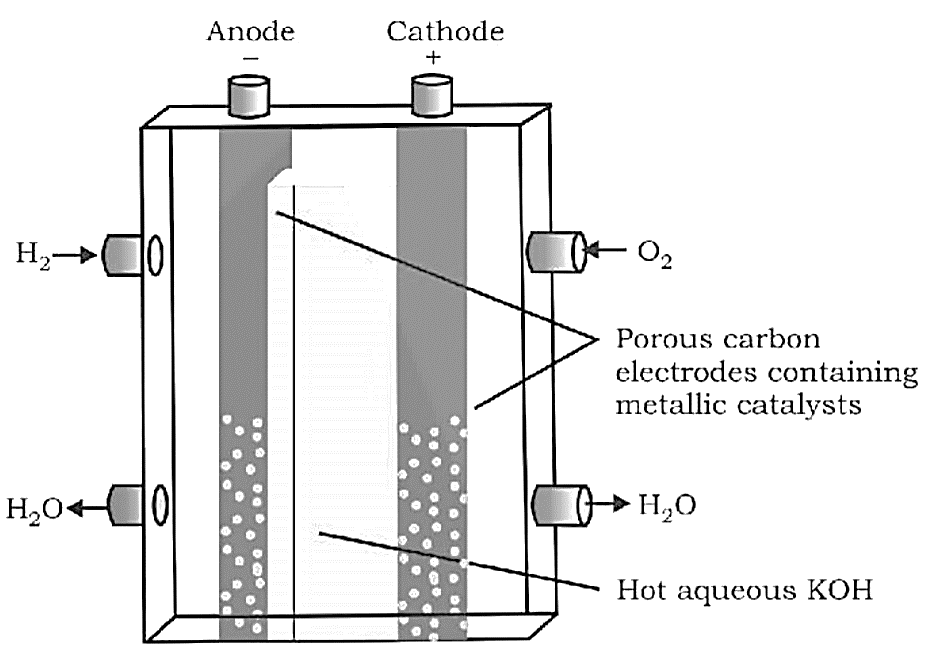
Corrosion
On the surface of iron or any other metal, it entails a redox process and the development of an electrochemical cell.
The oxidation of iron (anode) occurs at one point, while the reduction of oxygen to generate water occurs at another (cathode).
Anode:
Cathode:
Overall Reaction:

Painting or coating iron with other metals, such as zinc, helps prevent it from rusting. Galvanisation is the name for the latter procedure. Because
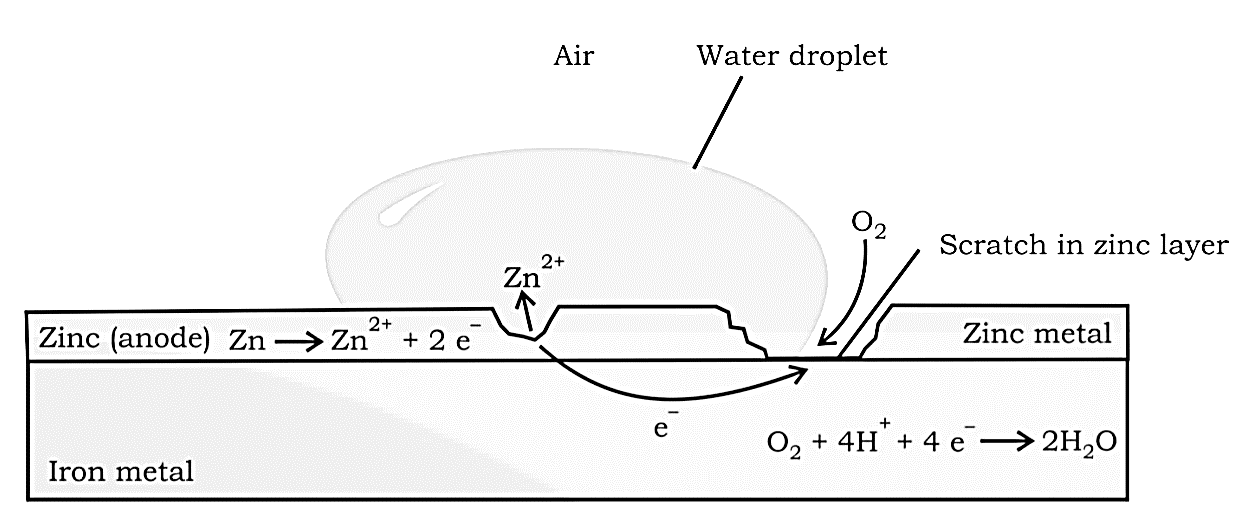
Conductance (G)
It is defined as the ease with which electric current passes through a conductor and is the reciprocal of resistance.
SI unit is Siemen (S).
Conductivity
It is the reciprocal of resistivity
Now is
As a result, the conductivity of an electrolytic solution can be defined as the conductance of a
Factors Affecting Electrolyte Conductance
Electrolyte
In a dissolved or molten form, an electrolyte is a substance that dissociates in solution to produce ions and hence conducts electricity.
Examples:
Electrolytic or ionic conductance refers to the conductance of electricity by ions present in solutions. The flow of electricity through an electrolyte solution is governed by the following factors.
Electrolyte Nature or Interionic Attractions: The lower the solute-solute interactions, the larger the freedom of ion mobility and the higher the conductance.
Ion Solvation: As the amount of solute-solvent interactions increases, the extent of solvation increases, and the electrical conductance decreases.
The Nature of the Solvent and its Viscosity: The larger the solvent-solvent interactions, the higher the viscosity, and the greater the solvent's resistance to ion flow, and thus the lower the electrical conductance.
Temperature: As the temperature of an electrolytic solution rises, solute-solute, solute-solvent, and solvent-solvent interactions diminish, causing electrolytic conductance to rise.
Measurement of Conductance
As we know,
If we measure
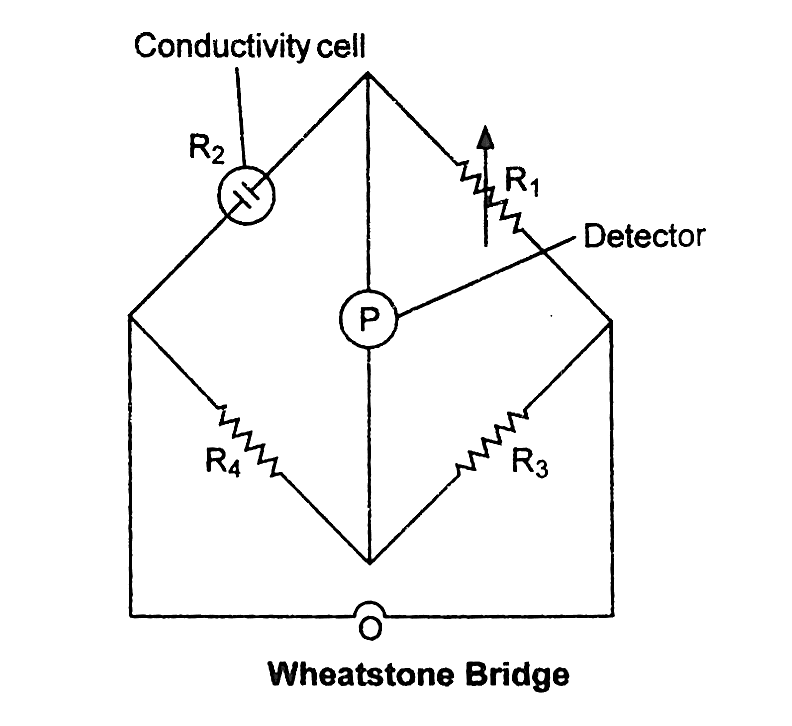
It is made up of two fixed resistances, R3 and R4, a variable resistance R1, and a conductivity cell with an unknown resistance, R2. When no current goes through the detector, the bridge is balanced. Then, in these circumstances:
Molar Conductivity
It's the total conducting power of all the ions created by dissolving one mole of an electrolyte between two big electrodes separated by one centimetre.
Mathematically,
where, V is the volume of solution in
Units:
Equivalent Conductivity
It is the electrical conductivity of one equivalent electrolyte placed between two big electrodes separated by one centimetre.
Mathematically:
Where, v is the volume of solution in
Units:
Variation of Conductivity and Molar Conductivity with Dilution
Because the number of ions per unit volume that carry the current in the solution reduces as concentration lowers, conductivity drops. With a decrease in concentration, molar conductivity rises. This is due to an increase in the total volume V of a solution containing one mole of electrolyte. The drop in
Graphical representation of the variation of
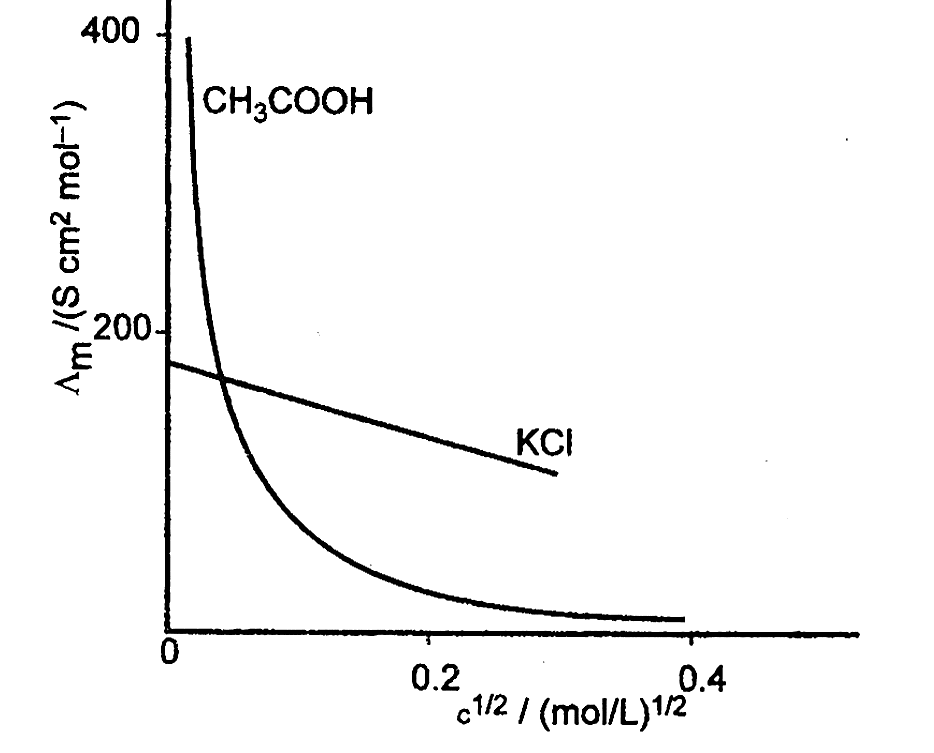
Limiting Molar Conductivity
Limiting molar conductivity, also known as molar conductivity at infinite dilution, is the value of molar conductivity as the concentration approaches zero. In the case of a strong electrolyte, extrapolation of the
The mathematical relationship between
In simplified form the equation can be given as:
Kohlrausch’s Law
It asserts that an electrolyte limiting molar conductivity can be described as the total of the individual contributions of the electrolyte's anion and cation.
In general, if an electrolyte produces
Applications of Kohlrausch’s Law
Calculation of molar conductivities of weak electrolyte at infinite dilution
For example, the molar conductivity of acetic acid at infinite dilution can be calculated using the molar conductivities of strong electrolytes like
Determination of Degree of Dissociation of Weak Electrolytes
Degree of dissociation
Determination of Dissociation Constant of Weak Electrolytes:
Use of
When we have two half-cell reactions that produce another half-cell reaction when we combine them, their emfs cannot be mixed directly. However, thermodynamic functions such as
We can clearly see that subtracting the first reaction from the second yields the third reaction. However, the same relationship does not hold true for EMF values.
That is:
Formula:
Where,
Where,
Where,
Where,
For a weak binary electrolyte AB
Where, K is the Dissociation constant
Nernst equation for a generation electrochemical reation
Where,
Where,
Where,
Standard Reduction Potential At 298 K. In Electrochemical Order
Reduction Potential in Alphabetical Order:
Some Important Questions on Electrochemistry
1. What is the meaning of the negative sign in the expression
Ans. The negative sign in the given expression implies that Zn is more reactive than hydrogen or that it is a stronger reducing agent than hydrogen. Zinc will be oxidised to
2. What are the conditions under which
Ans. When at equilibrium,
3. Can we measure the absolute electrode potential of an electrode?
Ans. No, it is not possible to measure the absolute potential of an electrode since the half-cell that contains a single electrode cannot work on its own, it can only work in combination with another half-cell.
Class 12 Chemistry Chapter 2: Details, Formulas and Concepts.
Nernst Equation: This equation relates the equilibrium potential of an electrochemical cell to the concentrations of the reactants and products involved. It's given as:
Gibbs Free Energy Change (ΔG): In electrochemistry, this concept is crucial as it determines whether a reaction is spontaneous or not. The relationship between Gibbs free energy change, cell potential, and temperature is given by:
Class 12 Chemistry Chapter 2 Important Topics and Subtopics Covered
S. No | Topic |
1 | Redox Reactions |
2 | EMF of a Cell |
3 | Standard Electrode Potential |
4 | Nernst Equation and Its Application to Chemical Cells |
5 | Relation Between Gibbs Energy Change and EMF of a Cell |
6 | Conductance in Electrolytic Solutions |
7 | Specific and Molar Conductivity |
8 | Variations of Conductivity with Concentration |
9 | Kohlrausch's Law |
10 | Electrolysis and Law of Electrolysis (Elementary Idea) |
11 | Dry Cell, Electrolytic Cells, and Galvanic Cells |
12 | Lead Accumulator |
13 | Fuel Cells |
14 | Corrosion |
Importance of Revision Notes for Class 12 Chemistry Chapter 2
Summarises Key Points: Condenses important concepts for quick review.
Saves Time: Provides a fast way to revise before exams.
Highlights Essentials: Focuses on crucial topics and definitions.
Improves Memory: Helps in better retention of information.
Enhances Exam Prep: Targets weak areas for more effective study.
Clarifies Concepts: Simplifies complex ideas for easier understanding.
Includes Visuals: Uses diagrams and charts for better grasp.
Boosts Confidence: Prepares students thoroughly for exams.
Tips for Learning the Class 12 Chemistry Chapter 2
Focus on core processes with illustrations and examples.
Draw and label diagrams for clarity.
Create summaries of each process.
Connect concepts to everyday examples.
Solve past exam questions to test understanding.
Explain concepts to others to reinforce learning.
Revisit material frequently to retain information.
Utilise platforms like Vedantu for additional support.
Conclusion
Vedantu's Electrochemistry Class 12 Revision Notes for CBSE Chemistry Chapter 2 provides a comprehensive and effective resource for students studying this topic. The Electrochemistry Revision notes cover all the important concepts outlined in the NCERT textbook, ensuring that students have a clear understanding of electrochemistry. Vedantu's notes are well-structured and easy to follow, making it easier for students to grasp complex concepts and solve problems.
Related Study Materials for Class 12 Chapter 2 Electrochemistry
S. No | Important Study Material Links for Class 12 Chemistry Chapter 2 |
1. | |
2. | |
3. |
Revision Notes Links for Class 12 Chemistry Revision Notes
S.No. | Chapter-wise Links for Class 12 Chemistry Revision Notes |
1 | |
3 | |
4 | |
5 | |
6 | |
7 | |
8 | |
9 | |
10 |
Related Study Material Links for Class 12 Chemistry
S.No. | Related Study Materials for Class 12 Chemistry |
1. | |
2. | |
3. | |
4. | |
5. | |
6. |
FAQs on Electrochemistry Class 12 Notes: CBSE Chemistry Chapter 2
1. What are Electrochemistry Class 12 Notes?
Electrochemistry Class 12 Notes by Vedantu provide detailed explanations of electrochemical processes, their applications, and essential concepts.
2. Where can I find Electrochemistry Notes?
You can access Electrochemistry Notes on Vedantu, covering important topics in a simplified and concise manner for quick understanding.
3. How can I download the Electrochemistry Notes Class 12 PDF?
Visit Vedantu to download the Electrochemistry Notes Class 12 PDF, which is available for free to support your exam preparation.
4. What is included in Class 12 Chemistry Electrochemistry Notes?
Class 12 Chemistry Electrochemistry Notes include key concepts like electrolysis, galvanic cells, and electrode potentials, explained clearly by Vedantu.
5. How can I get the Electrochemistry Class 12 Notes PDF Download?
You can easily get Electrochemistry Class 12 Notes PDF Download from Vedantu’s website by accessing the free resources section.
6. What are Electrochemistry Class 12 Short Notes?
Electrochemistry Class 12 Short Notes provide a brief yet comprehensive summary of important topics, perfect for quick revision before exams.
7. Can I download the Electrochemistry Notes PDF for Free?
Yes, Vedantu offers Electrochemistry Notes PDF Free Download for students to enhance their understanding of the chapter effortlessly.
8. Are Electrochemistry Class 12 Notes useful for exams?
Vedantu’s Electrochemistry Class 12 Notes are highly useful for exams, as they cover essential topics and include practice problems.
9. What makes Vedantu’s Electrochemistry Notes Class 12 PDF helpful?
Vedantu’s Electrochemistry Notes Class 12 PDF simplifies complex topics with clear explanations and important examples.
10. Why should I download Electrochemistry Class 12 Short Notes?
Downloading Electrochemistry Class 12 Short Notes from Vedantu helps students with quick reviews, making last-minute revisions easier.
















